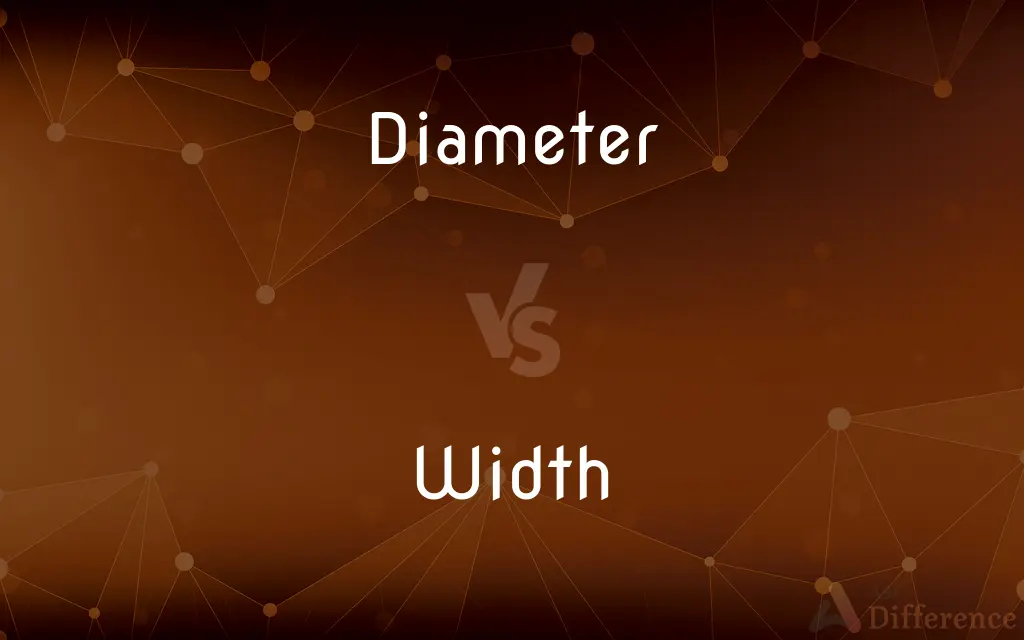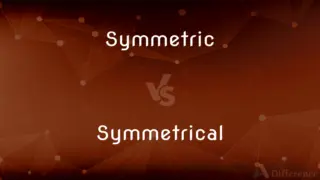Diameter vs. Width — What's the Difference?
By Tayyaba Rehman — Updated on September 7, 2023
Diameter refers to the distance across a circle, passing through its center. Width is the measurement of how broad something is from side to side, and it is not necessarily circular.

Difference Between Diameter and Width
Table of Contents
ADVERTISEMENT
Key Differences
Diameter specifically refers to the length of a straight line passing through the center of a circle and touching its boundaries on both ends. It is a term commonly used in geometry to describe the size of circles and spherical objects. Width, on the other hand, is a more general term that describes the measurement of an object from one side to the other, regardless of its shape.
While diameter is exclusively used for circular objects, width has a broader application. Width can be used to describe the measurement of rectangles, squares, and other shapes, including even circles when you are not going through the center. In common parlance, you may hear people refer to the "width of a tire," even though tires are circular, because they are not emphasizing the center-to-edge distance.
One of the key distinctions between diameter and width is that diameter is always a particular type of width; that is, the greatest possible width that can be measured across a circle. The width of a non-circular object, however, does not have the same constraints and could vary depending on the orientation in which it's measured.
In various fields like engineering, design, and mathematics, the correct usage of the terms diameter and width is crucial. Using "width" when you mean "diameter" or vice versa could result in misunderstandings that may affect the outcome of a project. For instance, the diameter of a pipe is critical in fluid dynamics calculations, while the width of a building element may be crucial in architectural design.
Comparison Chart
Specificity
Specific to circles
General term for many shapes
ADVERTISEMENT
Geometry
Important in circular geometry
Important in various geometric shapes
Constraints
Always through the center
No fixed point of measurement
Applicability
Limited to circular shapes
Applies to a wide range of shapes
Unit of Measurement
Usually in linear units
Usually in linear units
Compare with Definitions
Diameter
Diameter is the distance across a circle through its center.
The diameter of the wheel is 20 inches.
Width
Width is the measurement from side to side.
The width of the fabric was 50 inches.
Diameter
Diameter is the longest chord of a circle.
The diameter divides the circle into two equal halves.
Width
Width can vary based on orientation.
The width of the river changes as it winds.
Diameter
Diameter is the widest distance across a circular object.
The tree's diameter showed it was very old.
Width
Width is applicable to a range of shapes.
The width of the rectangle was less than its length.
Diameter
Diameter is twice the radius of a circle.
The diameter was easily calculated as twice the radius.
Width
Width does not require a fixed point of measurement.
She measured the width at various points.
Diameter
Diameter is crucial in calculations involving circles.
Incorrect diameter measurements will ruin the engineering project.
Width
Width is an important measure in various contexts.
Knowing the width of the door helped in moving the sofa.
Diameter
In geometry, a diameter of a circle is any straight line segment that passes through the center of the circle and whose endpoints lie on the circle. It can also be defined as the longest chord of the circle.
Width
The measurement or extent of something from side to side; the lesser of two or the least of three dimensions of a body
The yard was about seven feet in width
Diameter
A straight line segment passing through the center of a figure, especially of a circle or sphere, and terminating at the periphery.
Width
Wide range or extent
The width of experience required for these positions
Diameter
The length of such a segment.
Width
The state, quality, or fact of being wide.
Diameter
Thickness or width.
Width
Abbr. w The measurement of the extent of something from side to side.
Diameter
A unit of magnification equal to the number of times an object's linear dimensions is increased by the magnifying apparatus.
Width
A piece of material measured along its smaller dimension or its crosswise grain, especially a piece of fabric measured from selvage to selvage.
Diameter
(geometry) Any straight line between two points on the circumference of a circle that passes through the centre/center of the circle.
Width
The state of being wide.
Diameter
(geometry) The length of such a line.
Width
The measurement of the extent of something from side to side.
Diameter
(geometry) The maximum distance between any two points in a metric space
Width
A piece of material measured along its smaller dimension, especially fabric.
Diameter
(graph theory) The maximum eccentricity over all vertices in a graph.
Width
(cricket) The horizontal distance between a batsman and the ball as it passes him.
Diameter
Any right line passing through the center of a figure or body, as a circle, conic section, sphere, cube, etc., and terminated by the opposite boundaries; a straight line which bisects a system of parallel chords drawn in a curve.
Width
(sports) The use of all the width of the pitch, from one side to the other.
Manchester United like to play with width.
Diameter
The length of a straight line through the center of an object from side to side; width; thickness; as, the diameter of a tree or rock.
Width
The quality of being wide; extent from side to side; breadth; wideness; as, the width of cloth; the width of a door.
Diameter
The distance through the lower part of the shaft of a column, used as a standard measure for all parts of the order. See Module.
Width
The extent of something from side to side
Diameter
The length of a straight line passing through the center of a circle and connecting two points on the circumference
Diameter
A straight line connecting the center of a circle with two points on its perimeter (or the center of a sphere with two points on its surface)
Common Curiosities
What is Diameter?
Diameter is the distance across a circle through its center.
What is Width?
Width is the measurement from one side to the other of an object.
Is Diameter used in geometry?
Yes, diameter is an essential concept in circular geometry.
Can Diameter be less than Width?
In circles, diameter is the maximum width. In other shapes, width can be less, equal, or greater than diameter.
What unit is used to measure Diameter and Width?
Both are usually measured in linear units like inches, feet, or meters.
Is Diameter a type of Width?
Yes, diameter can be considered a specific type of width for circles.
Can Width be used for circular shapes?
Yes, but it won't be as specific as using the term diameter.
Is Diameter always twice the Radius?
Yes, diameter is always twice the radius in a circle.
Is Diameter the same for all directions in a circle?
Yes, the diameter will always be the same regardless of how it's oriented.
Can Width vary within the same object?
Yes, the width can change depending on where and how it's measured.
Does Width have a direction?
No, width is a measure of extent from one side to another and doesn't imply direction.
Do Diameter and Width have to be straight lines?
Yes, both are linear measurements.
Is Width used in geometry?
Yes, width is used to describe various shapes in geometry.
How is Width used in real life?
It's used in everyday language to describe the breadth of objects like furniture, roads, or rivers.
How is Diameter used in real life?
It's often used in engineering, construction, and design where precise measurements of circular objects are needed.
Share Your Discovery

Previous Comparison
Credulity vs. Credulous
Next Comparison
Symmetric vs. SymmetricalAuthor Spotlight
Written by
Tayyaba RehmanTayyaba Rehman is a distinguished writer, currently serving as a primary contributor to askdifference.com. As a researcher in semantics and etymology, Tayyaba's passion for the complexity of languages and their distinctions has found a perfect home on the platform. Tayyaba delves into the intricacies of language, distinguishing between commonly confused words and phrases, thereby providing clarity for readers worldwide.














































